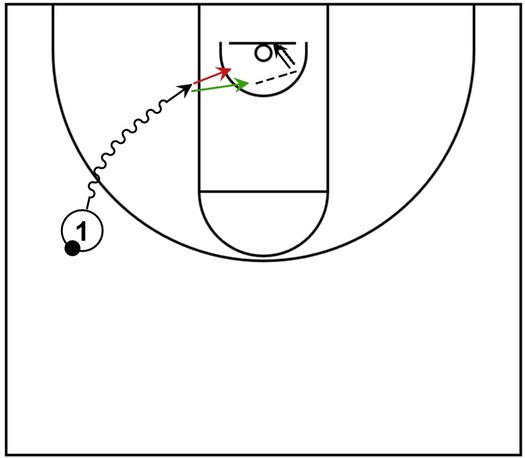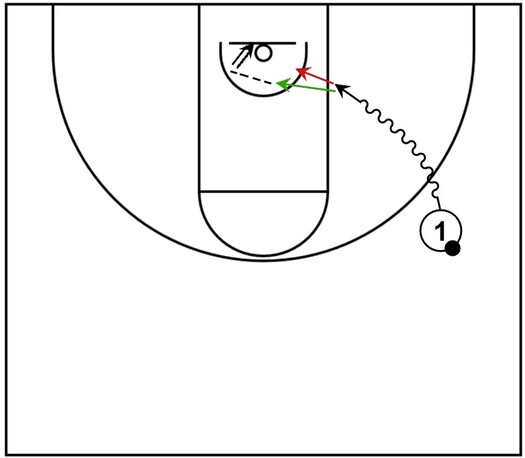General definition of reverse layup
The reverse layup consists of action that occurs when an offensive player in possession of the basketball near the rim typically jumps in the air and shoots the ball on the opposite side of the backboard’s inner rectangle.
General instructions to perform the reverse layup
This section contains the general instructions on how to perform the reverse layup, particularly for a beginner.
Additionally, the instructions below apply to an offensive player executing a reverse layup with the left hand or with the right hand while initially dribbling the ball.
What’s more, the subsections below include diagram examples, which can, hopefully, be a visual representation of the offensive action in relation to the reverse layup.
It should be noted though that the diagram is not drawn to scale and is mainly displayed as a visual illustration as stated before.
In essence, an actual reverse layup will most likely have some variation, particularly in reference to the specific areas that a player may dribble, step, or jump while performing the layup.
Moreover, the offensive player on the diagram as well as within the general instructions will be denoted simply as 1.
Basic left hand reverse layup

Prior to executing the reverse layup, 1 starts near the left side wing area behind the three-point line with possession of the basketball, represented by the black dot.
Next, 1 should begin dribbling the ball, represented by the wavy arrow, toward the basket with the left hand.
Furthermore, since 1 is dribbling near the baseline that is behind the basket, this is generally called the baseline side.
Afterwards, upon reaching the lane line (it’s the line that connects the edge of the free throw line down to the baseline), 1 should take the penultimate step.
This is the first step with the left foot, prior to executing the reverse layup, preferably just inside of the lane.
On the diagram, the penultimate step, in this instance, is represented by the solid red arrow.
Additionally, while that penultimate step is happening, 1 should also begin gathering the ball with both hands.
Following that, 1 should take the second (and final) step with the right foot, prior to executing the reverse layup.
The second step should also be as close as possible to middle of the lane, which can potentially increase the efficiency of the reverse layup.
In relation to the diagram, the second step, in this instance, is represented by the solid green arrow.
Moving on, after taking that second step with the right foot, 1 should immediately jump in the air off that same foot and allow momentum to carry them from the left side of the basket towards the right side.
On the diagram, the momentum for 1 is indicated by the black dotted lines within the lane area.
From there, as the momentum carries 1 towards the right side of the basket, 1 should shoot the ball over the left shoulder with the left hand and aim for the top right corner of the backboard’s inner rectangle.
Additionally, to provide more clarity of the actual shooting process for the left hand reverse layup, 1 should essentially hold the ball with the left palm facing up, let go of it with the right hand while still holding it with the left hand, and finally flick the left wrist upon releasing it.
Simply put, 1 will shoot an underhanded layup over the left shoulder towards the top right corner of the backboard’s inner rectangle.
That is to say, the reverse layup with the left hand is very similar to the underhanded variation of the standard left hand layup, which would be taken on the left side of the rim, particularly by flipping the ball with an underhanded shot near the top left corner of the backboard’s inner rectangle.
The main difference is that the left hand reverse layup is taken on the right side of the rim, particularly by flipping the ball towards the top right corner of the backboard’s inner rectangle, as mentioned previously.
In reference to the diagram, the reverse layup shot attempt is represented by the wide arrow pointing towards the horizontal line, which is the backboard of the basket, in this instance.
Basic right hand reverse layup

This part of the instructions is similar to the previous subsection, except that the details are generally in reverse, pun intended.
Prior to executing the reverse layup, 1 starts near the right side wing area behind the three-point line with possession of the basketball, represented by the black dot.
Next, 1 should begin dribbling the ball on the baseline side toward the basket with the right hand.
Afterwards, upon reaching the lane line, 1 should take the penultimate step.
This is the first step with the right foot, prior to executing the reverse layup, preferably just inside of the lane.
On the diagram, the penultimate step, in this instance, is represented by the solid red arrow.
Additionally, while that penultimate step is happening, 1 should also begin gathering the ball with both hands.
Following that, 1 should take the second step with the left foot, prior to executing the reverse layup.
The second step should also be as close as possible to middle of the lane, which can potentially increase the efficiency of the reverse layup.
In relation to the diagram, the second step, in this instance, is represented by the solid green arrow.
Continuing on, after taking that second step with the left foot, 1 should immediately jump in the air off that same foot and allow momentum to carry them from the right side of the basket towards the left side.
On the diagram, the momentum for 1 is indicated by the black dotted lines within the lane area.
From there, as the momentum carries 1 towards the left side of the basket, 1 should shoot the ball over the right shoulder with the right hand and aim for the top left corner of the backboard’s inner rectangle.
Additionally, to provide more clarity of this for the right hand reverse layup, 1 should essentially hold the ball with the right palm facing up, let go of it with the left hand while still holding it with the right hand, and finally flick the right wrist upon releasing it.
Simply put, 1 will shoot an underhanded layup over the right shoulder towards the top left corner of the backboard’s inner rectangle.
Essentially, the reverse layup with the right hand is very similar to the underhanded variation of the standard right hand layup, which would be taken on the right side of the rim, particularly by flipping the ball with an underhanded shot near the top right corner of the backboard’s inner rectangle.
The main difference is that the right hand reverse layup is taken on the left side of the rim, particularly by flipping the ball towards the top left corner of the backboard’s inner rectangle, as mentioned previously.
In reference to the diagram, the reverse layup shot attempt is represented by the wide arrow pointing towards the horizontal line, which is the backboard of the basket, in this instance.
Additional concepts and insights about the reverse layup
Field goal
The reverse layup is also a type of field goal, especially in reference to organized competition. In essence, as it relates to organized play and basketball statistics, whenever an offensive player shoots a reverse layup, that same player is also attempting a field goal at the very least.
Potentially effective against defender with height advantage
The reverse layup could be potentially effective, particularly when a defender possesses a height advantage over the offensive player who would be attempting the layup.
Essentially, the reverse layup gives the offensive player an opportunity to use the rim as protection against the defender’s possible block attempt, which could be quite useful in situations against certain rim protectors.
Can perform reverse layup without dribbling or large momentum
It is feasible to perform the reverse layup without dribbling first and/or without gathering a large amount of momentum so that the player can glide through the air.
Basically, an offensive player could execute the reverse layup from a standstill or simply by jumping from one side of the lane to the other side and reverse the ball on the inner rectangle.
For example, let’s say that a player cut to the basket or was already standing under the rim. Afterwards, let’s also say that player received the ball from a teammate while in the lane area under the basket.
From that point, the player could technically execute the reverse layup by placing the ball on the inner rectangle relative to their direction.